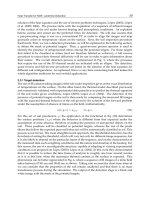Materials Selection Deskbook 2011 Part 2 pdf
Bạn đang xem bản rút gọn của tài liệu. Xem và tải ngay bản đầy đủ của tài liệu tại đây (216.22 KB, 15 trang )
Overall
Process
System
Design
3
stage. Figure 1.1 is a simplified flow diagram illustrating some of the major
activities and their normal sequence. From the initial idea the engineer is
directed to prepare a preliminary design basis. This includes a rough flow
plan, a review
of
the potential hazards of the process and an assimilation of
all
available technical, economic and socioeconomic information and data.
At this stage of
a
project often the engineer
or
engineers are not the final
equipment designers, but merely play the devil’s advocate, by establishing
the equipment requirements. Dialog established between the conceptual
design engineer and the process designer results in an initial process flow
plan. From the flow plan, a preliminary cost estimate is prepared, many
times by a different engineer whose expertise is cost estimating. Once
management approval is received, the design engineer’s work begins. In the
initial stages the design engineer will help prepare a preliminary engineering
flow plan, select the site and establish safety requirements.
This
initial project stage is often considered a “predesign” period, which
constitutes the basis of the conceptual design. Usually a collection
of
indi-
viduals are involved in discussions and planning. The cast of characters
includes the project engineer, who oversees the entire project, the design
engineer (with whom we are most concerned), safety engineer, environmental
engineer and, perhaps, a representative from management and additional
support personnel.
Once the overall process has been designed conceptually, a more detailed
engineering flow plan is prepared. This flow plan serves two purposes;
(1)
to
document the logic behind the process operation, and
(2)
to identify in
detail major process equipment, including all control devices. A complete
flow plan also will identify potential hazards and their consequences, in
addition
to
how they are handled. After the environmental and safety engi-
neers have reviewed all potential hazards related
to
handling toxic materials,
noise, radiation, etc., recommendations are outlined for safe and standard
handling and disposal practices. These recommendations often affect the
overall system design, resulting in revised plans.
The next stage is the actual construction of the unit according
to
the
revised plans. By now, the design engineer is totally involved and has selected,
sized and designed most
of
the equipment and process piping, based
(hopefully) on the standard practices outlined in this book. During the
actual construction phase, the design engineer will list and review the plans
with the project engineer.
At the completion of the unit
or
system construction, a prestartup review
is
conducted
by
the designer and
his
support personnel.
This
should include
a review of all operating, as well as emergency and shutdown, procedures.
The prestartup review normally involves the following personnel in addition
to the designer: project engineer, trained operating personnel, operations
foreman, the company environmental engineer, the division and company
safety engineers and representatives
from
management.
At
this point, any
4
Materials Selection
Deskbook
Overall
Process
System
Design
5
additional changes
or
recommendations to the process design are made.
Major process revisions may be requested by the operations foreman, project
engineers, design engineer, safety and environmental coordinators and/or
plant operating personnel. Table
1.1
summarizes major items that are con-
sidered in the operating procedures planning.
The project planning activities may be much more complex than illustrated
Table
1.1.
Major
Items in Operating Guidelines Planning
PURPOSE OF PROCESS OR OPERATION
0
General Discussion of Process
What will be done (brief summary)
Chemistry involved
Major unit operations
HdzdrdS involved-severity
Protective equipment-what, where, when
Area restrictions-what, where, when
Ventilation
0
Personnel Protection
0
Startup
Preparation and handling
Feedstocks
Catalysts
Equipment
0
Step-by-step Description
Flow plans
Sketches
Labelled parts of units
Position
of
valves, control settings, etc.
0
Sampling and Final Product Form
Description
of
equipment
Actions required
Step-by-step description
0
Shutdown Procedure
Flow plans
Sketches
Labelled parts
of
unit
Position of valves, control settings, etc.
0
Emergency Shutdown Procedure
Action required
Followup required
Emergency personnel/outside organizations
Description
Hazards or precautions
0
Product or Waste
Disposal
0
Unit Cleaning Procedures
6
Materials Selection
Deskbook
by the simple flow diagram of Figure
1.1.
This depends, of course, on the
magnitude
of
the project. Often, large complex system planning has numer-
ous checkpoints at various stages where a continuous review of technical and
revised economic forecasts is performed.
Also
not shown in this flow dia-
gram is the legal framework
for
obtaining construction and operating permits
as well
as
preparing the environmental impact statement and meeting
local,
state and federal regulations.
1.3.
EQUlPMENT AND LNSTRUMENTATION
CODES
Process and instrumentation flow diagrams (P
&
I
diagrams) essentially
define the control and operating logic behind a process as well as provide a
visual record to management and potential users. In addition, P
&
I
diagrams
are useful at various stages of a project’s development by providing:
0
0
0
0
0
the opportunity for safety analysis before construction begins;
a tabulation of equipment and instrumentation
for
cost estimating purposes;
guidelines
for
mechanics and construction personnel during the plant assembly
stage;
guidance in analyzing startup problems;
assistance in training operating personnel; and
assistance in solving daily operating and sometimes emergency problems.
P
&
I
diagrams contain four important pieces
of
information, namely,
all
vessels, valves and piping, along with a brief description and identifying
specifications of each;
all
sensors, instruments and control devices, along
with a brief description
of
each; the control logic used in the process; and,
finally, additional references where more detailed information can be ob-
tained.
Information normally excluded from
P
&
I diagrams includes electrical
wiring (normally separate electrical diagrams must be consulted), nonprocess
equipment (e.g., hoist, support structures, foundations, etc.) and scale
drawings of individual components.
There are basically two parts to the diagram: the first provides a schematic
of equipment and the second details the instrumentation and control devices.
The P
&
I
diagram provides a clear picture of what each piece of equipment
is, including identifying specifications, the size of various equipment,
materials of construction, pressure vessel numbers and ratings, and drawing
numbers. Equipment and instrumentation are defined in terms
of
a code
consisting of symbols, letters and a numbering system. That is, each piece
of equipment is assigned its own symbol; a letter is used to identify each
type of equipment and to assist
in
clarifying symbols, and numbers are used
to
identify individually each piece of equipment within a given equipment
type. Table
1.2
illustrates common equipment symbols and corresponding
letter codes.
Overall
Process
System
Design
7
Table 1.2. Common Equipment
Symbols
and
Letter
Codes
~ ~~
Equipment
Symbol Code Information Needs
Conrrol
valve
Piping
Valves
Centrifugal
Pump
Rotameter
Reactor
Filter
Back Pressure
Regulator
cv
P
a
__c=l_
LOADING
BAS
-&
Tracing
Spring-Loaded
Relief Valve
Size, maximum flowrate,
pressure drop
Material, size, wall
thickness
Type: ball
(B),
globe
(G),
needle
(N),
etc.
Inlet/outlet pressure,
flowrate
R Tube, float, body,
maximum flowrate
R
Pressure vessel
no.,
drawing no., size
FIL Pore size
Range
of
gauge and
loading source
Shown
on
vessel with
power pack and control
signal
Type: steam
(S)/
electric (E)
Relief pressure, orifice
size
8
Materials
Selection
Deskbook
When denoting instrumentation it is important that definitions be under-
stood clearly. Terms
for
instruments and controls most often included on
P
&
I
diagrams are given below:
Instrument Loop-A combination
of
one
or
more interconnected instru-
ments arranged
to
measure
or
control a process variable.
Final Control Element-A device that directly changes the value
of
the
variable used to control a process condition.
Transducer (Converter) A device that receives
a
signal from one power
source and outputs a proportional signal in another power system. A trans-
ducer can act as a primary element, transmitter
or
other device.
Fail Closed (usually normally closed)-An instrument that will
go
to the
closed position
on
loss
of
power (pneumatic, electric, etc.).
Fail Open (usually normally open)-An instrument that
will
go
to the open
position on loss
of
power (pneumatic, electric, etc.).
Fail Safe-An instrument that on loss of power (pneumatic, electric, etc.)
wd1 go to a position that cannot create a safety hazard.
Process Variable-A physical property or condition in a fluid
or
system.
Instrument-A device that measures or controls a variable.
Local-An instrument located on the equipment.
Remote-An instrument located away from the equipment (normally a
Primary Element-A device that measures a process variable.
Indicator-A device that measures a process variable and displays that
variable at the point of measurement.
Transmitter-A device that senses a process variable through a primary
element and puts out a signal proportional
to
that variable
to
a remotely
located instrument.
Controller-A device that varies its output automatically in response to
changes in a measured process variable
to
maintain that variable at a desired
value (setpoint).
Instrumentation normally is denoted by a circle in which the variable
being measured or controlled
is
denoted by an appropriate letter symbol
inside the circle. When the control device is to be located remotely, the
circle is divided in half with a horizontal line. Table
1.3
gives various
instrumentation symbols and corresponding letter codes. The specific
op-
erating details and selection criteria for various process instrumentation are
not discussed in this book. The reader is referred to earlier works by
Cheremisinoff
[
1,2]
for discussions on essential control and measurement
instrumentation.
Piping normally is denoted by solid lines. Piping lines on the P
&
I
diagram
should be accompanied by the following identifying information:
control cabinet).
1.
line
number,
2.
nominal pipe
size
and
wall
thickness,
Overall
Process
System
Design
9
Table 1.3. Typical lnstrument Codes and Examples
General Symbols
0
Instrument process
piping
lnstrument air lines
Electrical leads
Capillary tubing
Locally mounted
instrument
(single service)
Locally mounted
transmitter
Board-mounted
transmitter
Diaphragm
motor
valve
$3
Electrically operated
valvc (solenoid
or
motor)
Piston-opcrated valve
(hydraulic or
pneumatic)
3-way body
for
any valve
Safety (relief) valve
Manually operated
control valve
~ ~~
Temperature Symbols
Temperature
recording controller
Temperature well
Temperature indicator
'd
Pressure Symbols
Pressure alarm
Pressure controller
(blind type)
Prcssurc indicator
(locally mounted)
Pressure recorder
(board mounted)
Flow Symbols
-
1-
Flow indicator,
I:low recorder
b
differential type
($
10
Materials Selection Deskbook
3.
origin and termination,
4.
design temperature and pressure,
5. specified corrosion allowance,
6.
7.
insulation type and thickness,
8.
9.
winterizing or process protection requirements (i.e., heat tracing via steam or
electric),
test pressure (indicate hydrostatic
or
pneumatic), and
piping flexibility range (e.g., the maximum
or
minimum operating temperature).
1.4.
VESSEL CODES AND FLANGE RATINGS
In
this first volume we shall direct much of our attention to vessel design.
In
the United States, the primary standard for pressure vessel design is that
of
the American Society
of
Mechanical Engineers (ASME).
(In
subsequent
chapters information
on
European codes for vessels shall be reviewed.) The
ASME code is essentially a legal requirement. It provides the minimum
construction requirements
for
the design, fabrication, inspection and certifi-
cation of pressure vessels. The ASME code does
not
cover: (1) vessels
subject
to
federal control;
(2)
certain water and hot water tanks,
(3)
vessels
with
an
internal operating pressure not exceeding
15
psig with
no
limitation
on
size; and
(4)
vessels having an inside diameter not exceeding
6
inches
with
no
limitation
on
pressure.
Flange ratings are also specified by the ASME. Table 1.4 gives the various
flange ratings in terms
of
the strength of materials, as based
on
ASME
standards. Table
1.5
gives data
on
flange pressure-temperature ratings.
Finally, Figure
1.2
gives data on allowable stress at different temperatures
for carbon steel pipe and
304
stainless steel plate.
All pressure vessels must pass appropriate hydrostatic testing before
approval for service.
For
safety reasons, hydrostatic pressure testing is
almost always recommended over a pneumatic test. The recommended
Table
1.4.
Flange Ratings for Different Materials
Strength of Materials
~~
Carbon Steel Stainless Steel
150
Ib
@
500°F
@
500°F
300
Ib
600
Ib
900
Ib
1500
Ib
2500
Ib
@
850°F
@
1000°F
I
Overall Process
System
Design
11
Table
1.5.
Typical Flange Pressure-Temperature Data
Carbon Steel
304
SS
”F
150
psia
300
psia
150
psia
300
psia
IO0
275 720 275 615
200 240
700
240 550
300 210 680 210 495
400
180 665 180 450
500 150 625 150 410
600
130
555
130
380
700 110 470 110 355
800
92
3
65 92
3
30
900 70 225 70 310
1000 40 85
40 300
1100
255
1200
155
- -
-
-
-
-
204300
I
I I
I
I
I
-
C.S.
SA
106
Gr.A
Y
W
-I
m
a
3
5,000
-
s
a
J
0
I
I
I
I
I
I
0
2
4
6
8
10
12
OF/
100
Figure
1.2.
Allowable stress
for
different materials.
hydrostatic test is typically
150%
of the temperature corrected design.
The
pneumatic test is typically
125%
of design, as recommended by
ASME.
A
“proof-test” is used when calculations are not possible.
This
requires at least
twice the maximum allowable pressure and employs a brittle coat
on
the
vessel to indicate overstress.
12
Materials
Selection
Deskbook
REFERENCES
1.
Cheremisinoff,
N.
P.
Applied
Iq'luid /+'low
Mtvzsurcnient
(New
York: Marcel
2.
Cheremisinoff,
N.
P.
Process
1,eivl
Instrumentation and Cotitrol
(New
Dekker, Inc.,
1979).
York: Marcel Dekker,
Inc.,
1981).
2.
DESIGN AND CORROSION
2.1
INTRODUCTION
Corrosion occurs in various forms and is promoted by a variety
of
causes,
all related to process operating conditions. It is a continuous problem that
can lead
to
contaminated process streams which leads to poor product
quality and unscheduled equipment shutdowns, which leads to reduced
production, and high maintenance and equipment replacement costs. Min-
imizing corrosion is a key consideration for the designer and can be accom-
plished in two ways:
(1)
proper material selection
for
apparatus, and
(2)
preventive maintenance practices. Both these approaches must be ex-
amined by the designer. This chapter reviews principles
of
corrosion causes
and control. It is important to recognize conditions that promote rapid
material degradation to compensate for corrosion in designing.
2.2
TYPES
OF
CORROSION
Corrosion is characterized by the controlling chemi-physical reaction that
promotes each type. Each of the major types is described below.
Uniform corrosion is the deterioration of a metal surface that occurs uni-
formly across the material. It occurs primarily when the surface is in contact
with an aqueous environment, which results in a chemical reaction between
the metal and the service environment. Since this form of corrosion results in
a relatively uniform degradation
of
apparatus material, it can be accounted
for most readily at the time the equipment is designed, either by proper
material selection, special coatings or linings,
or
increased wall thicknesses.
Galvanic corrosion results when two dissimilar metals are in contact, thus
forming a path
for
the transfer
of
electrons. The contact may be
in
the form
of a direct connection (e.g., a steel union joining two lengths
of
copper
13
14
Materials Selection Deskbook
piping),
or
the dissimilar iiietals may be immersed in an electrically con-
ducting medium (e.g., an elcctrolytic solution). One metal acts as an anode
and, consequently, suffers more corrosion than the other metal, which acts
as the cathode. The driving force
for
this type of corrosion is the electro-
chemical potential existing between two metals. This potential difference
represents an approximate indication of the rate at which corrosion will take
place. That is, corrosion rates will be faster in service environments where
electrochemical potential differences between dissimilar metals are high.
Thermogalvanic corrosion is promoted by an electrical potential caused by
temperature gradients and can occur on the same material. The region
of
the
metal higher in temperature acts as an anode and thus undergoes a high rate
of corrosion. The cooler region
of
the metal serves as the cathode. Hence,
large temperature gradients on process equipment surfaces exposed to
service environments will undergo rapid deterioration.
Erosion corrosion occurs in an environment
where there is flow
of
the
corrosive medium over the apparatus surface. This type
of
corrosion is
greatly accelerated when the flowing medium contains solid particles. The
corrosion rate increases with velocity. Erosion corrosion generally manifests
as a localized problem due
to
maldistributions of flow in the apparatus.
Corroded regions are often clean, due
to
the abrasive action of moving par-
ticulates, and occur in patterns or waves in the direction of flow.
Concentration cell corrosion occurs in an environment in which an electro-
chemical cell is affected by a difference in concentrations in the aqueous
medium. The most common form is crevice corrosion. If an oxygen concen-
tration gradient exists (usually at gaskets and lap joints), crevice corrosion
often occurs. Larger concentration gradients cause increased corrosion (due
to
the larger electrical potentials present).
Cavitation corrosion occurs when a surface is exposed
to
pressure changes
and high-velocity flows. Under pressure conditions, bubbles form on the
surface. Implosion of the bubbles causes local pressure changes sufficiently
large to flake off microscopic portions of metal from the surface. The result-
ing surface roughness acts
to
promote further bubble formation, thus in-
creasing
the
rate of corrosion.
Fretting corrosion occurs where there is friction between two metal
surfaces. Generally, this friction is caused by vibrations. The debris formed
by fretting corrosion accelerates the damage. initial damage
is
done by
contact welding. Vibrations cause contact welds to break, with subsequent
surface deterioration. Debris formed acts
to
accelerate
this
form of corrosion
by serving as an abrasive. Fretting corrosion is especially prevalent in areas
where motion between surfaces is not foreseen. If allowances for vibration
are not made during design, fretting corrosion may be a strong candidate.
Pitting corrosion is a form of localized corrosion in which large pits are
formed in the surface of a metal usually in contact with an aqueous solution.
Design
and
Corrosion
15
The pits can penetrate the metal completely. The overall appearance of the
surface involved does not change considerably; hence, the actual damage is
not readily apparent. Once
a
pit forms, it acts as a local anode. Conditions
such as debris and concentration gradients in the pit further accelerate
degradation. There are several possible mechanisms for the onset of pitting
corrosion. Slight damage
or
imperfections
in
the metal surface, such as a
scratch
or
local molecular dislocation, may provide the environment neces-
sary for the beginning
of
a pit.
Exfoliation corrosion is especially prevalent in aluminum alloys. The grain
structure
of
the metal determines whether exfoliation corrosion will occur.
In this form of corrosion, degradation propagates below the surface
of
the
metal. Corrosion products in layers below the metal surface cause flaking of
the metal.
Selective leaching occurs when a particular constituent of an alloy is re-
moved. Selective leaching occurs in aqueous environments, particularly
acidic solutions. Graphitization and dezincification are two common forms
of selective leaching. Dezincification is the selective removal of zinc from
alloys containing zinc, particularly brass. The mechanism of dezincification
of brass involves dissolving the brass with subsequent plating back of copper
while zinc remains in solution. Graphitization is the selective leaching of
iron
or
steel from gray cast irons.
Intergranular corrosion occurs selectively along the grain boundaries
of
a
metal.
This
is an electrochemical corrosion in which potential differences
between grain boundaries and the grain become the driving force. Even with
relatively pure metals
of
only one phase, sufficient impurities can exist along
grain boundaries to allow for intergranular corrosion. Intergranular corrosion
is generally not visible until the metal is in advanced stages of deterioration.
These advanced stages appear as rough surfaces with loose debris (dislodged
grains). Welding can cause local crystal graphic changes, which favor inter-
granular corrosion. It is especially prevalent near welds.
Stress corrosion cracking is an especially dangerous form of corrosion. It
occurs when a metal under a constant stress (external, residual
or
internal)
is exposed to a particular corrosive environment. The effects
of
a particular
corrosive environment vary for different metals.
For
example, Inconel-600
exhibits stress corrosion cracking in high-purity water with only a few parts
per million of contaminants at about
300°C.
The stress necessary for this
type of corrosion to occur is generally of the residual
or
internal type. Most
external stresses are not sufficient to induce stress corrosion cracking.
Ex-
tensive cold working
or
the presence of a rivet are common stress providers.
Corrosion products also can build up to provide stress sufficient to cause
stress corrosion cracking. The damage done by stress corrosion cracking
is
not obvious until the metal fails. This aspect
of
stress corrosion cracking
makes it especially dangerous.
16
Materials Selection Deskbook
Corrosion fatigue is caused by the joint action
of
cyclically applied stresses
and a corrosive medium (generally aqueous). Metals will
fail
due to cyclic
application of stress (fatigue). The presence of
an
aqueous corrosive environ-
ment causes such failure more rapidly. The frequency of the applied stress
affects the rate
of
degradation
in
corrosion fatigue. Ordinary fatigue is
generally not frequency dependent. Low-frequency applied stresses cause
more rapid corrosion rates. Intuitively, low frequencies cause extended
contact time between cracks and the corrosive medium. Generally, the
cracks formed are transgranular.
Hydrogen blistering is caused by bubbling of a metal surface due to
absorbed hydrogen. Monatomic hydrogen can diffuse through metals,
whereas diatomic hydrogen cannot. Ionic hydrogen generated by chemical
processes (such as electrolysis
or
corrosion) can form monatomic hydrogen
at a metal surface.
This
hydrogen can diffuse through the metal and combine
on the far side
of
the metal forming diatomic hydrogen. The diffusion hydro-
gen also can combine in voids in the metal. Pressure within the void increases
until the void actually grows (visibly apparent as a blister) and ultimately
ruptures, leading to mechanical failure.
Hydrogen embrittlement is due to the reaction
of
diffused hydrogen with a
metal. Different metals undergo specific reactions, but the result is the same.
Reaction with hydrogen produces a metal that is lower in strength and more
brittle.
Decarburization results from hydrogen absorption from gas streams at
elevated temperatures. In addition to hydrogen blistering, hydrogen can
remove carbon from alloys. The particular mechanism depends to a large
extent on the properties of other gases present. Removal of carbon causes
the metal
to
lose strength and fail.
Grooving is a type of corrosion particular to environmental conditions
where metals are exposed to acid-condensed phases.
For
example, high
concentrations
of
carbonates in the feed to a boiler can produce steam in the
condenser to form acidic condensates. This type of corrosion manifests as
grooves along the surface following the general flow
of
the condensate.
Biological corrosion involves all corrosion mechanisms in which some living
organism
is
involved. Any organism, from bacteria and fungi
to
mussels,
which can attach themselves
to
a metal surface, can cause corrosion. Bio-
logical processes may cause corrosion by producing corrosive agents, such as
acids. Concentration gradients also can be caused by localized colonies
of
organisms. Some organisms remove protective films from metals, either
directly
or
indirectly, leaving the actual metal surface vulnerable to corrosion.
By selective removal of products of corrosion, biological organisms also can
cause accelerated corrosion reactions. There are also some bacteria that
directly digest certain metals (e.g., iron, copper
or
aluminum). Micro-
organisms also may promote galvanic corrosion by removing hydrogen from
Design
and
Corrosion
17
the surface of a metal causing a potential difference
to
be created between
different parts of the metal.
Stray
current corrosion
is an electrolytic degradation of a metal caused by
unintentional electrical currents. Bad grounds are the most prevalent causes.
The corrosion is actually a typical electrolysis reaction.
Gaseous
corrosion
is a general form of corrosion whereby a metal is
exposed
to
a gas (usually at elevated temperatures). Direct oxidation of a
metal
in
air
is the most common cause. Cast iron growth is a specific
form
of
gaseous corrosion
in
which corrosion products accumulate onto the metal
surface (and particularly at grain boundaries)
to
the extent that they cause
visible thickening of the metal. The entire metal thickness may succumb
to
this
before
loss
of strength causes failure.
Tuberculation
occurs in aqueous solutions. Mounds form over metal
sur-
faces providing for concentration differences, favorable environments for
biological growth, and an increase in acidity leading
to
hydrogen formation.
Deposit attack
occurs when there is nonuniform deposition of a fdm on a
metal surface. The most common form appears as unequal scale deposits in
an aqueous environment. Unequal film provides
for
concentration cells,
which degrade the metal by galvanic means.
Impingement
is corrosion caused by aerated water streams constricting
metal surfaces. It
is
similar
to
erosion corrosion in which air bubbles take the
place of particles. The pits formed by impingement attack have a character-
istic
tear drop shape.
Liquid metal corrosion
occurs when a metal is in contact with a liquid
metal. The main type of corrosion with highly pure liquid metals is simple
solution. The solubility of the solid metal in the liquid metal controls the
rate of damage. If a temperature gradient exists, a much more damaging
form
of corrosion takes place. Metal dissolves from the higher temperature zone
and crystallizes out
in
the colder zone. Transfer of solids
to
liquid metal is
greatly accelerated by thermal gradients. If two dissimilar metals are in con-
tact with the same liquid metal, the more soluble metal exhibits serious
corrosion. The more soluble metal dissolves along with alloys from the less
soluble metal. Metal in solutions may move by gross movement of the liquid
metal
or
by diffusion. Depending on the system, small amounts of impurities
may cause corrosive chemical reactions.
High-temperature
corrosion is induced by accelerated reaction rates in-
herent in any temperature reaction. One phenomenon that occurs frequently
in
heavy oil-firing boilers is layers of different types of corrosion on one
metal surface.
Causes
of
corrosion are the subject
of
extensive investigation by industry.
Almost
any type
of
corrosion can manifest itself under widely differing
operating conditions.
Also,
different types of corrosion can occur simul-
taneously.
It
is not uncommon
to
see crack growth from stress corrosion to









